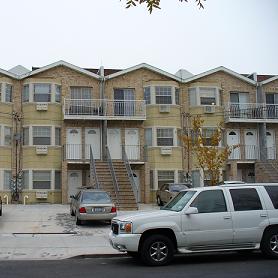The Department of City Planning has been busy working on new zoning regulations that the agency hopes will help reduce the problems caused by too much pavement replacing open soil areas. The city believes that not only will these measures help to prevent future flooding, but it will also make the city greener, which is an initiative set forth in Mayor Bloomberg’s PlanYC.
Yards Text Amendment
The first is the Yards Text Amendment. This change would require a minimum percentage of planting in the front yards of low-rise residential areas. Twenty to fifty percent of most front yards, depending on width, would have to remain unpaved under the new rules, and this would apply to about 70 percent of residential lots throughout the city. The regulation is aimed primarily at new developments. Yards that currently are paved over would be allowed to remain in their present condition, but owners of existing homes within these districts will be prohibited from paving over their yards.
Certain loopholes that currently allow developers to not include yards in the plans for their properties would also be closed. No longer allowed would be steeply sloped driveways – the maximum gradient under the new code would be 11%. A new regulation that prohibits parking in front yards will only apply in R1 and R2 districts, which are not present in western Queens.
However, the contextual rezoning planned for parts of Maspeth, Middle Village and Glendale, a process started in 2004 but not yet certified by city planning, would include some limitations on the use of front yards and curb cuts in R4 and R5 districts, which make up just about every residential district in these neighborhoods.
Councilman Tony Avella cautioned that the Department of Buildings will enforce the regulations, but will depend on private citizens to report infractions. “The city waited too long to make a move toward eliminating this problem, but this is a good step forward. Of course there is more work that needs to be done.”
Independent zoning consultant Paul Graziano added, “It’s a belated response that’s way overdue. We’ve been waiting an awfully long time. This is all coming out because of the floods. Unfortunately, the damage has been done.”
Street Tree Planting Text Amendment
Another measure taken to reduce heat entrapment and radiation is a proposed street tree and planting strip requirement in residential areas. The rule would make green strips and street tree planting mandatory in front of new developments, major enlargements of existing structures, and certain conversions from one use to another in all “R” zones. A tree would be required at intervals of 25 feet along the sidewalks surrounding the lot. The property owner would be responsible for planting the trees, after which maintenance would be handled by the Department of Parks and Recreation. This is the more controversial of the proposed zoning text changes because of its vagueness with regards to who would be financially responsible for the planting of the tree.
Currently, homeowners may voluntarily request free street trees from the Parks Department through their council member or community board. An arborist from the agency inspects the site to see if planting is feasible at the desired location and if so, chooses and plants an appropriate species from Parks’ inventory. However, this process currently may take up to 2 years. The new rules would require that a tree be planted in front of city-owned property within the district if the location inside a zone that requires street tree planting is deemed to not be appropriate. Under the new rules, it is unclear what the time frame would be for planting of trees or if requesting free street trees via the Parks Department route will fulfill this requirement. For this reason, some are feeling apprehensive about the new rule.
“The Juniper Park Civic Association is all for increasing green space, however, we are not in favor of passing the costs of the trees onto the homeowner,” said JPCA President Robert Holden. “It should be the builder who is responsible and we want to make sure this is not an attempt by the Bloomberg administration to push more costs onto the middle class instead of expanding their free street tree planting program as they had promised.”
Avella agrees with JPCA on this one. He also brought up another shortcoming he identified with regards to the proposed regulation. “This amendment will not protect old growth trees on private property, and the city should provide incentives to homeowners to do that. A large established tree is much more valuable to the environment than a sapling,” he said.
Graziano says he believes city planning needs to identify areas which have clusters of old growth trees and create zoning overlays to protect them.
The new city-wide requirements are being considered by 59 Community Boards and the five Borough Presidents. Following receipt of their recommendations, the City Planning Commission holds public hearings on the proposals which will subsequently require approval by the City Council.




